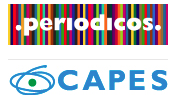Estratégias para o alcance de objetivos afetivos no ensino remoto
DOI:
https://doi.org/10.35699/2237-5864.2020.24493Palavras-chave:
Objetivos afetivos, Ensino remoto, Ensino híbrido, Pandemia, Covid-19Resumo
O trabalho ora apresentado foi motivado pela ampla utilização da videoconferência como alternativa às aulas presenciais em decorrência da pandemia provocada pela Covid-19. Pode ser caracterizado como um ensaio teórico que tem como proposta discutir a eficácia do ensino remoto para o alcance de objetivos afetivos de aprendizagem. Os objetivos mais facilmente alcançáveis mediante aulas expositivas — e consequentemente mediante videoconferências — são os cognitivos, notadamente nos níveis de memorização e compreensão. Quando os objetivos de aprendizagem estão no domínio afetivo — que envolvem emoções, sentimentos e atitudes —, outras estratégias são requeridas. Assim, com base na contribuição de teóricos no campo dos objetivos de aprendizagem e nos resultados de pesquisas empíricas, procede-se à discussão das possibilidades de utilização de diferentes estratégias mediante plataformas de cursos on-line. São discutidas as estratégias de discussão reflexiva, trabalho colaborativo, grupo de verbalização/grupo de observação, tutoria por pares, dramatização, simpósio, seminário e gamificação. O estudo aponta para a adoção do ensino híbrido como forma preferencial de ensino superior no cenário pós-pandemia, mas que deve vir acompanhado da capacitação dos docentes na utilização de estratégias de ensino grupal.
Downloads
Referências
AKOS, Patrick; KRETCHMAR, Jen. Investigating grit at a non-cognitive predictor of college success. The Review of Higher Education, Baltimore, v. 40, n. 2, p. 163-186, 2017. Disponível em: https://muse.jhu.edu/article/640608. Acesso em: 06 ago. 2020. DOI: https://doi.org/10.1353/rhe.2017.0000.
ANDERSON, Lorin W. et al. A taxonomy for learning, teaching, and assessing: A revision of Bloom's taxonomy of educational objectives. Essex: Longman, 2001.
BAKER, Ryan Shaun J. D. et al. Better to be frustrated than bored: The incidence, persistence, and impact of learners’ cognitive–affective states during interactions with three different computer-based learning environments. International Journal of Human-Computer Studies, Amsterdã, v. 68, n. 4, p. 223-241, 2010. Disponível em: https://www.sciencedirect.com/science/article/abs/pii/S1071581909001797. Acesso em: 06 ago. 2020. DOI: https://doi.org/10.1016/j.ijhcs.2009.12.003.
BERGMANN, Jonathan. Sala de aula invertida. São Paulo: Grupo Gen-LTC, 2016.
BIRBECK, David. Graduate qualities and the affective domain: New horizons to explore. 2009. Tese (Doutorado em Educação) – Learning and Teaching Unit, University of South Australia, Adelaide, 2009.
BLOOM, Benjamin Samuel et al. Taxonomy of educational objectives: the classification of educational goals: handbook I: cognitive domain. Nova Iorque: D. Mckay, 1956.
BOBBITT, John Franklin. How to Make a Curriculum. Boston: Houghton Mifflin, 1924.
BOLIN, Aaron U.; KHRAMTSOVA, Irina; SAARNIO, David. Using student journals to stimulate authentic learning: balancing Bloom's cognitive and affective domains. Teaching of Psychology, Oxfordshire, v. 32, n. 3, p. 154-159, 2005. Disponível em: https://www.tandfonline.com/doi/abs/10.1207/s15328023top3203_3. Acesso em: 06 ago. 2020. DOI: https://doi.org/10.1207/s15328023top3203_3.
CATE, Olle Ten; DE HAES, Hanekke (JCJM). Summative assessment of medical students in the affective domain. Medical Teacher, [S.l], v. 22, n. 1, p. 40-43, 2000. DOI: https://doi.org/10.1080/01421590078805.
CLEVELAND-INNES, Martha; ALLY, Mohamed. Learning to feel: Education, affective outcomes and the use of online teaching and learning. European Journal of Open, Distance and E-learning, Berlim, v. 10, n. 2, p. 1-17, 2007. Disponível em: https://www.eurodl.org/?p=archives&year=2007&halfyear=2&..&abstract=285. Acesso em: 06 ago. 2020.
D'MELLO, Sidney; GRAESSER, Art. Dynamics of affective states during complex learning. Learning and Instruction, Amsterdã, v. 22, n. 2, 145-157, 2012. Disponível em: https://www.sciencedirect.com/science/article/abs/pii/S0959475211000806. Acesso em: 29 set. 2020. DOI: https://doi.org/10.1016/j.learninstruc.2011.10.001.
DU BOULAY, Bento. Projetando interação educacional afetiva e cognitiva. In: LUCKIN, Rosemary et al. Handbook of Design in Educational Technology. Nova Iorque: Routledge, 2013. p. 168-175. Disponível em: encurtador.com.br/Fagms. Acesso em: 06 ago. 2020.
ECCLESTONE, Kathryn; HAYES, Dennis. Afetar: conhecimento, comunicação, criatividade e emoção. 2008. Disponível em: https://www.researchgate.net/publication/265454681_The_Dangerous_Rise_of_Therapeutic_Education. Acesso em: 06 ago 2020. DOI: https://doi.org/10.4324/9780203870563.
FALOUT, Joseph; ELWOOD, James; HOOD, Michael. Demotivation: Affective states and learning outcomes. System, Amsterdã, v. 37, n. 3, p. 403-417, 2009. Disponível em: https://www.sciencedirect.com/science/article/abs/pii/S0346251X09000566. Acesso em: 06 ago 2020. DOI: https://doi.org/10.1016/j.system.2009.03.004.
FASSO, Wendy; KNIGHT, Bruce Allen. Afetam no aprendizado on-line: resultados, emoções e estados afetivos. In: Aplicações Inovadoras de Pedagogia Online e Design de Cursos. Hershey: IGI Global, 2018. p. 128-153.
GIL, Antonio Carlos. Metodologia do ensino superior. São Paulo: Atlas, 2020.
GREENWOOD, Charles R.; CARTA, Judith J.; HALL, R. Vancel. The Use of Peer Tutoring Strategies in Classroom Management and Educational Instruction, School Psychology Review, Londres, v. 17, n. 2, 258-275, 1988. DOI: https://doi.org/10.1080/02796015.1988.12085342.
GRIFFIN, Lynda; ROY, James. A great resource that should be utilised more, but also a place of anxiety: student perspectives on using an online discussion forum. Open Learning: The Journal of Open, Distance and e-Learning, Londres, p. 1-16, 2019. DOI: https://doi.org/10.1080/02680513.2019.1644159.
GRONLUND, Norman E. How to write and use instructional objectives. Englewood Cliffs: Merrill/Prentice-Hall, 1995.
HOMER, Bruce D.; PLASS, Jan L.; BLAKE, Linda. The effects of video on cognitive load and social presence in multimedia-learning. Computers in Human Behavior, Amsterdã, v. 24, n. 3, 786-797, 2008. Disponível em: https://www.sciencedirect.com/science/article/abs/pii/S0747563207000544. Acesso em: 29 set. 2020. DOI: https://doi.org/10.1016/j.chb.2007.02.009.
HORN, Michael B.; STAKER, Heather. Blended: usando a inovação disruptiva para aprimorar a educação. Porto Alegre: Penso, 2015.
JAGGER, Suzy. Affective learning and the classroom debate. Innovations in Education and Teaching International, Londres, v. 50, n. 1, p. 38-50, 2013. Disponível em: https://srhe.tandfonline.com/doi/abs/10.1080/14703297.2012.746515. Acesso em: 06 ago. 2020. DOI: https://doi.org/10.1080/14703297.2012.746515.
JOHNSON, David W.; JOHNSON, Roger T. Fazendo funcionar a aprendizagem cooperativa. Teoria em prática, [S.l.], v. 38, n. 2, p. 67-73, 1999.
KRATHWOHL, David R.; BLOOM, Benjamin S.; MASIA, Bertram B. Taxonomy of educational objectives, handbook ii: affective domain. Nova Iorque: David McKay Company, 1964.
LEE, Cheng-Yuan. Student motivation in the online learning environment. Journal of Educational Media & Library Sciences, Taiwan, v. 37, n. 4, p. 367-375, 2000. Disponível em: http://joemls.dils.tku.edu.tw/fulltext/37/37-4/367-375.pdf. Acesso em: 06 ago. 2020.
LYNCH, Sandra; HART, Bethne; COSTA, Catherine M. Giving voice to values: An undergraduate nursing curriculum project. Collegian, Palo Alto, v. 21, n. 4, p. 367-373, 2014. Disponível em: https://www.sciencedirect.com/science/article/abs/pii/S1322769613000929. Acesso em: 06 ago. 2020. DOI: https://doi.org/10.1016/j.colegn.2013.09.004.
MAGER, Robert F. Preparing instructional objectives. Palo Alto: Fearon Publishers, 1962. Disponível em: https://eric.ed.gov/?id=ED018143. Acesso em: 29 set. 2020.
MAJURI, Jenni; KOIVISTO, Jonna; HAMARI, Juho. Gamification of education and learning: A review of empirical literature. In: GAMIFIN 2018, 2., 2018. Pori. Proceedings of the 2nd international GamiFIN conference. Pori: CEUR-WS, 2018. p. 11-19. Disponível em: https://trepo.tuni.fi/bitstream/handle/10024/104598/gamification_of_education_2018.pdf. Acesso em: 29 set. 2020.
MARTIN, Barbara L.; BRIGGS, Leslie J. The affective and cognitive domains: Integration for instruction and research. Nova Jérsei, Educational Technology, 1986. Disponível em: encurtador.com.br/jtFIU. Acesso em: 06 ago. 2020.
MARTIN, Florence; PARKER, Michele A. Use of synchronous virtual classrooms: Why, who, and how. MERLOT Journal of Online Learning and Teaching, Long Beach, v. 10, n. 2, p. 192-210, 2014.
MOORE, Schuster M. Theory of transactional distance. In: KEEGAN, Desmond. (ed.), Theoretical principles of distance education. Nova Iorque: Routledge, 1997. p. 22-38.
MOORE, Michael G.; KEARSLEY, Gres. Educação a distância: sistemas de aprendizagem on-line. São Paulo: Cengage Learning, 2013.
MORENO, Jacob Levy. Fundamentos do psicodrama. São Paulo: Summus, 1983.
NORTHEY, Gavin et al. Increasing student engagement using asynchronous learning. Journal of Marketing Education, Londres, v. 37, n. 3, p. 171-180, 2015. DOI: https://doi.org/10.1177/0273475315589814.
OLATUNJI, Michael Olalekan. Online Education: Issues, Challenges and Implications. Khazar Journal of Humanities & Social Sciences, Baku, v. 16, n. 3, 2013. Disponível em: https://jhss-khazar.org/wp-content/uploads/2010/04/0005KHAZAR_Journal_of_Humanities_and_Social_Sci_ences1.pdf. Acesso em: 06 ago. 2020.
SEELS, Barbara; GLASGOW, Zita. Exercises in instructional design. Columbus: Merrill Publishing Company, 1990.
SHOFFNER, Melanie. The place of the personal: Exploring the affective domain through reflection in teacher preparation. Teaching and Teacher Education, Amsterdã, v. 25, n. 6, p. 783-789, 2009. Disponível em: https://www.sciencedirect.com/science/article/abs/pii/S0742051X08002011. Acesso em: 06 ago 2020. DOI: https://doi.org/10.1016/j.tate.2008.11.012.
SHORT, John; WILLIAMS, Ederyn; CHRISTIE, Bruce. The social psychology of telecommunications. [S.l.]: John Wiley & Sons, 1976.
SNELSON, Chareen; ELISON-BOWERS, Patt R. Using YouTube videos to engage the affective domain in e-learning. In: MENDEZ-VILAS; Antonio et al. Research, Reflections and Innovations in Integrating ICT in Education. Badajoz: Formatex, 2009. p. 1481-1485. Disponível em: https://scholarworks.boisestate.edu/edtech_facpubs/50/. Acesso em: 06 ago. 2020.
TYLER, Ralph W. Basic principles of curriculum and instruction. Chicago: University of Chicago Press, 1949.
VAN DER HOEVEN KRAFT, Katrien J. et al. Engaging students to learn through the affective domain: A new framework for teaching in the geosciences. Journal of Geoscience Education, Northfield, v. 59, n. 2, p. 71-84, 2011. Disponível em: https://www.tandfonline.com/doi/abs/10.5408/1.3543934a. Acesso em: 06 ago. 2020. DOI: https://doi.org/10.5408/1.3543934a.
WHITE, Karl R. T-groups revisited: Self-concept change and the "Fish-Bowling" technique. Small Group Behavior, Pensilvânia, v. 5, n. 4, p. 473-485, 1974. DOI: https://doi.org/10.1177/104649647400500407.

Downloads
Publicado
Edição
Seção
Licença
Copyright (c) 2020 Antonio Carlos Gil, Arquimedes Pessoni

Este trabalho está licenciado sob uma licença Creative Commons Attribution 4.0 International License.
Autores que publicam nesta revista mantêm os direitos autorais e concedem à revista o direito de primeira publicação, com o trabalho simultaneamente licenciado sob a Licença Creative Commons Attribution que permite o compartilhamento do trabalho com reconhecimento da autoria e publicação inicial nesta revista.
Autores têm autorização para assumir contratos adicionais separadamente, para distribuição não-exclusiva da versão do trabalho publicada nesta revista (ex.: publicar em repositório institucional ou como capítulo de livro), com reconhecimento de autoria e publicação inicial nesta revista.
Política de acesso aberto:
A Revista Docência do Ensino Superior é um periódico de Acesso Aberto, o que significa que todo o conteúdo está disponível gratuitamente, sem custo para o usuário ou sua instituição. Os usuários podem ler, baixar, copiar, distribuir, imprimir, pesquisar ou vincular os textos completos dos artigos, ou usá-los para qualquer outra finalidade legal, sem solicitar permissão prévia do editor ou do autor, desde que respeitem a licença de uso do Creative Commons utilizada pelo periódico. Esta definição de acesso aberto está de acordo com a Iniciativa de Acesso Aberto de Budapeste (BOAI).


























